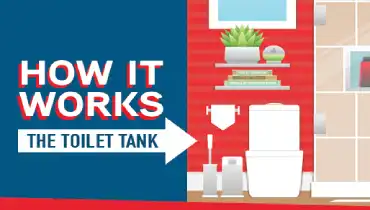
Every modern toilet has two parts: the tank and the bowl. The tank is the upper part that holds about two gallons of reserve water. The bowl is the lower part where you deposit liquid and solid waste. In this two-part series about how your toilet works, we’ll explore toilet tank parts, which experience the most movement and are most prone to breaking.
Purpose of a Toilet Tank
Toilets are so effective at washing away waste because of the siphon action they create. A household water pipe at normal pressure isn’t powerful enough to activate a siphon.
That’s why the tank is necessary. It takes roughly 30 to 60 seconds to fill a toilet tank between flushes, but with a press of the handle, all the water is dumped into the bowl in about three seconds. This is like pouring a bucket of water into a bowl. At this rate, the siphoning effect essential for toilet function is achieved with every flush.
Inside a Toilet Tank
Take a look at the toilet flush parts that work together inside the tank:
- Handle: The part on the outside of the tank. Press the handle to initiate a flush.
- Handle arm: The pivoting component inside the tank that’s attached to the handle.
- Chain: The component that connects the handle arm to the flapper.
- Flapper: A rubber mechanism that seals the drain hole between flushes.
- Flush valve: The component attached to the toilet tank flapper that holds this rubber seal open while water flows into the bowl.
- Drain hole: The piece of plumbing that connects the toilet tank to the bowl.
- Fill valve: The device that refills the tank in preparation for the next flush.
- Refill tube: A rubber tube that directs water from the fill valve to the tank.
- Filler float/float ball: Some toilets have a filler float while others have a float ball attached to the fill valve via a float arm. Both types of floats serve the same purpose, which is to tell the fill valve to turn on the water when the tank is empty and to turn back off when the tank is full.
- Overflow tube: A failsafe in case the float ball becomes detached or the filler valve jams. Instead of allowing the tank to overflow, this tube redirects extra water into the bowl.
The Flush
When you press the handle, the toilet goes into action. The handle arm raises and lifts the chain connected to it, which opens the flapper and activates the flush valve. As a result, water rushes into the bowl through the drain hole to wash the waste out of the toilet bowl.
The Refill
The filler float/float ball lowers when the tank empties, telling the fill valve to turn on the water. This refills the tank through the refill tube in preparation for the next flush. At the same time, the flapper closes over the drain hole to seal it off from the bowl. The tank fills with water, stopping when the filler float/float ball rises to a predetermined level. If the float ball becomes detached or the filler valve jams, an overflow tube acts as a fail-safe, directing extra water into the bowl so your bathroom doesn’t flood.
The toilet is a technological marvel we all take for granted today. But if any of the toilet parts inside the tank fail, you’ll suddenly stop taking your toilet for granted. Whether you need toilet tank replacement parts or an expert plumber to get your malfunctioning toilet back up and running, give Mr. Rooter Plumbing a call.

